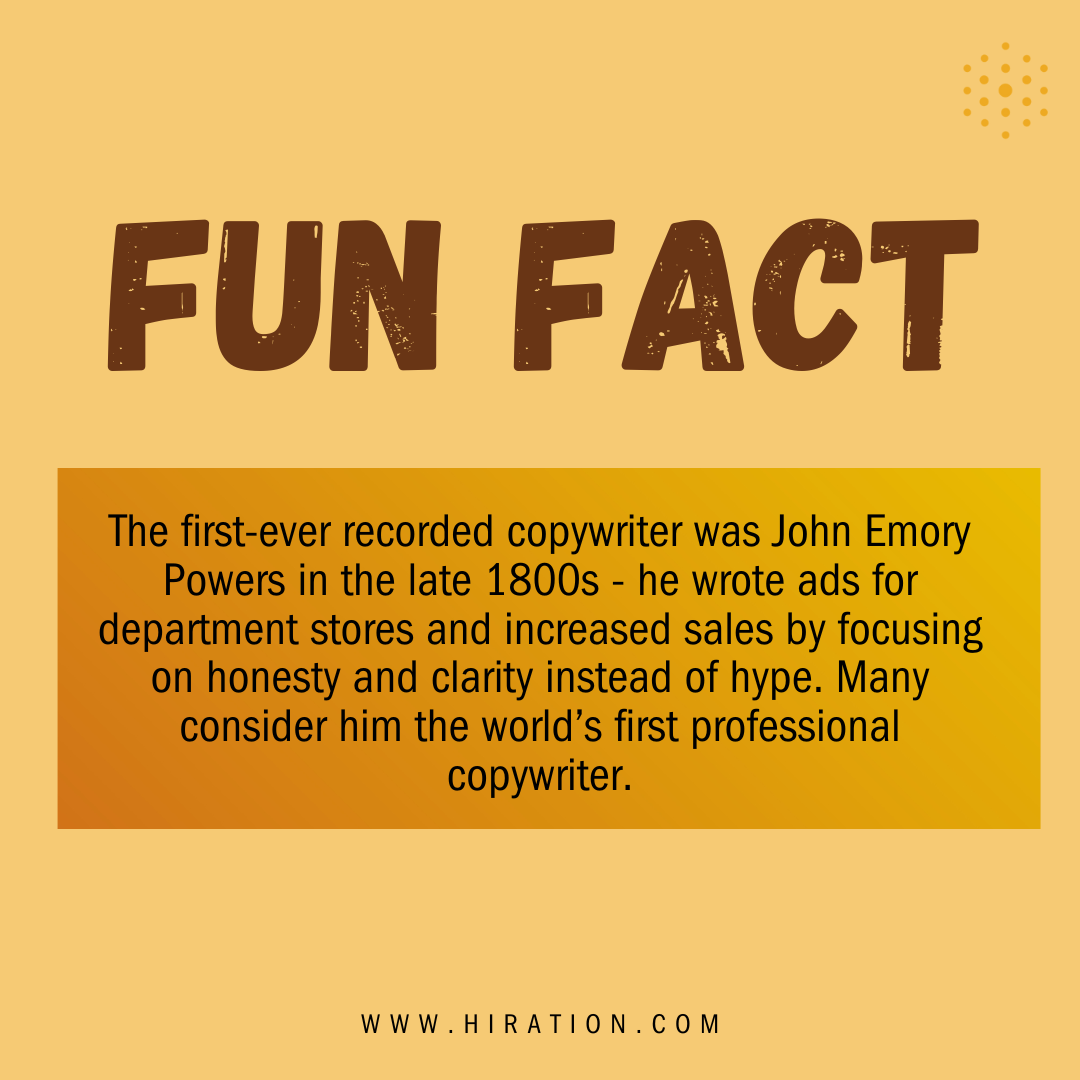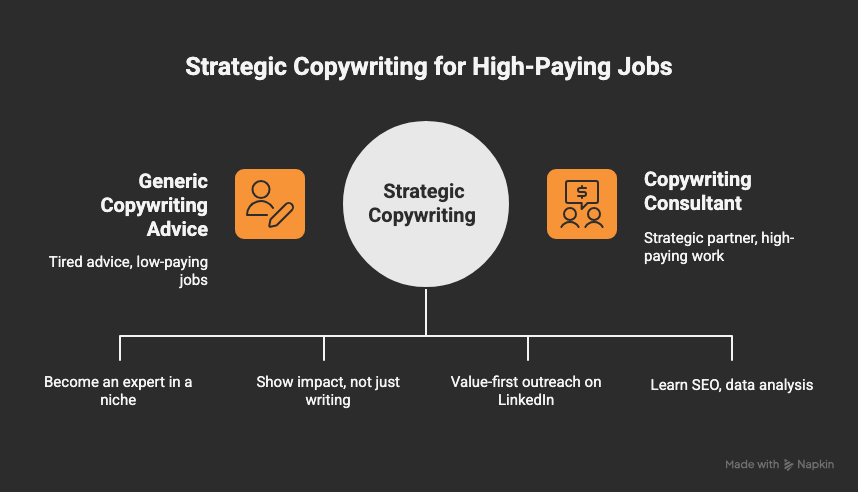How can you actually get high-paying copywriting jobs in 2025?
Breaking into well-paying copywriting work today isn’t about writing better—it’s about positioning yourself as a strategic, data-driven partner. By choosing a niche, showcasing measurable results in your portfolio, mastering LinkedIn networking and cold outreach, and adding SEO and analytics skills, you can stand out in a saturated market. Copywriters who combine storytelling with strategy and measurable ROI consistently out-earn generalists.
If you’ve searched for "how to get copywriting jobs," you've been flooded with the same generic advice: "Build a portfolio," "Pitch clients," and "Try Upwork."
That advice is tired, and frankly, it’s what everyone else is doing.
While the median income for copywriters sits at $62,672 per year, only the top performers - those who position themselves as strategic partners rather than just writers, break into the six-figure range.
The path to high-paying, consistent copywriting work isn’t about being a "good writer." It’s about being a strategic, data-driven partner.
Here are 4 actionable strategies based on what is actually working right now, backed by research and data.
Should I Really Pick a Niche to Get a Job?
Yes, absolutely. Generalists compete with everyone for low-paying jobs. A niche (like "email copy for SaaS" or "blogs for fintech") positions you as an expert, which attracts high-quality clients and justifies premium rates.
According to Upwork, freelance writers with a defined niche reported significantly higher incomes than generalists.
Instead of "I write blog posts," your pitch becomes, "I write SEO-driven, patient-education blogs for dental practices that convert web traffic into appointments."
See the difference?
What Do Clients Actually Want to See in a Portfolio?
Clients want proof of results, not just pretty writing. Your portfolio must be a collection of case studies showing how your copy solved a business problem, like increasing conversions, lowering ad costs, or improving user engagement.
Stop showing clients a Google Doc of your writing. Show them the impact of your writing.
HubSpot's 2025 State of Marketing report found that 51% of marketers list "improving ROI/attribution" as their top challenge. Your portfolio is your chance to show them you are the solution.
Actionable Steps:
- Frame every portfolio piece as a mini case study: 1. The Problem, 2. The Solution (your copy), 3. The Result (the metric).
- No results yet? Create "spec" (speculative) work. Find a landing page with bad copy, rewrite it, and show your process and why your version is better, citing conversion principles.
- Your portfolio is an extension of your professional brand, which starts with a strong resume summary that sells your unique value.

Where Are the Good Copywriting Jobs Hiding?
The best, high-paying jobs are rarely on public job boards. They are found through strategic networking on LinkedIn and targeted, value-first cold outreach. You must go to the clients directly before they even write a job description.
Although the U.S. Bureau of Labor Statistics (BLS) projects steady 4% growth for writers from 2022-2032, the competition is fierce. You have to hunt.
So instead:
1. Master LinkedIn: This is your #1 tool. An Oktopost report revealed that 80% of all B2B social media leads come from LinkedIn.
- Action: Don't just "connect." Follow marketing managers at 20 companies in your niche. Engage with their posts for a week. Then send a connection request with a message.
- Action: Your profile must be a sales page, not a history lesson. A strong LinkedIn profile is essential to attract clients.
2. Send Value-First Cold Emails: Generic "hire me" emails are deleted. Send a "mini-audit."
- Action: Find a small, specific flaw in a company's copy (e.g., a confusing CTA, a weak email subject line).
- Action: Send a short email: "Hi [Name], I'm a copywriter specializing in [your niche]. I noticed on your product page that the CTA is 'Learn More.' A/B testing often shows 'Get Your Demo' performs better for this audience. Just a thought! Happy to share other ideas if you're interested."
- This approach is like sending a hyper-specific cover letter that solves a problem before they even ask.
Is "Good Writing" Enough to Get Hired?
No. Good writing is the baseline expectation. High-paying clients hire for "T-shaped" skills: deep writing ability (the vertical bar) combined with broad marketing knowledge (the horizontal bar), especially SEO, data analysis, and conversion.
Clients want a partner who understands the business of content, not just the art of it.
The Digital Marketing Institute's 2024 research identified "SEO/SEM" and "data analysis" as top in-demand skills for modern marketers.
If you can talk about how your copy will improve "time on page" or "keyword rankings," you are a far more valuable asset.
Actionable Steps:
- Take a free course on Google Analytics. Learn to read a basic report.
- Learn the fundamentals of SEO. Understand how to use keywords naturally and write for user intent.

Your Next Move
Stop acting like a "writer for hire" and start acting like a "copywriting consultant."
The difference is in the strategy.
Niche down, build an ROI-focused portfolio, network intelligently on LinkedIn, learn the marketing skills that surround your writing, and create your own experience. That is how you get hired.
And if you want your resume, cover letter, interview answers, and LinkedIn profile to reflect that strategic edge, Hiration can help.
Our AI-powered platform is built to make your professional brand stand out - whether you're pitching clients or applying for your next full-time role.
Copywriting Jobs — FAQ
Do I need a niche to get high-paying copywriting jobs?
Yes. Specializing in a niche—like SaaS, fintech, or healthcare—sets you apart as an expert and justifies premium rates. Data from Upwork shows that writers with a defined niche consistently earn more than generalists.
What should I include in a copywriting portfolio?
Show results, not just samples. Frame each piece as a case study with the problem, your solution, and measurable results (e.g., conversions or engagement). Use data to show business impact, not just writing style.
Where do the best copywriting jobs come from?
Most high-paying roles come through LinkedIn networking or direct outreach, not job boards. Engage with marketing leaders in your niche, and send value-first emails with quick wins or insights about their copy.
Is “good writing” enough to get hired?
No. Good writing is expected. To stand out, develop “T-shaped” skills: deep writing expertise plus knowledge of SEO, analytics, and conversion strategy. Clients want strategic partners, not just writers.
How can I attract clients on LinkedIn?
Make your profile a sales page—highlight your niche, expertise, and client outcomes. Engage with relevant posts, share your insights, and use a strong headline that clearly states your value.
What’s a “value-first” cold email?
Instead of asking for work, offer immediate value. Example: point out a weak call-to-action on a company’s site and suggest a fix based on conversion data. This approach shows expertise and initiative.
What marketing skills should copywriters learn?
Learn SEO basics, keyword research, Google Analytics, and A/B testing principles. According to the Digital Marketing Institute, SEO and data analysis are among the most in-demand skills for copywriters today.
How can Hiration help me get copywriting jobs?
Hiration’s AI-powered platform helps you position yourself as a strategic copywriter—optimizing your resume, LinkedIn profile, and interview prep to reflect your results-driven expertise and attract higher-value opportunities.



